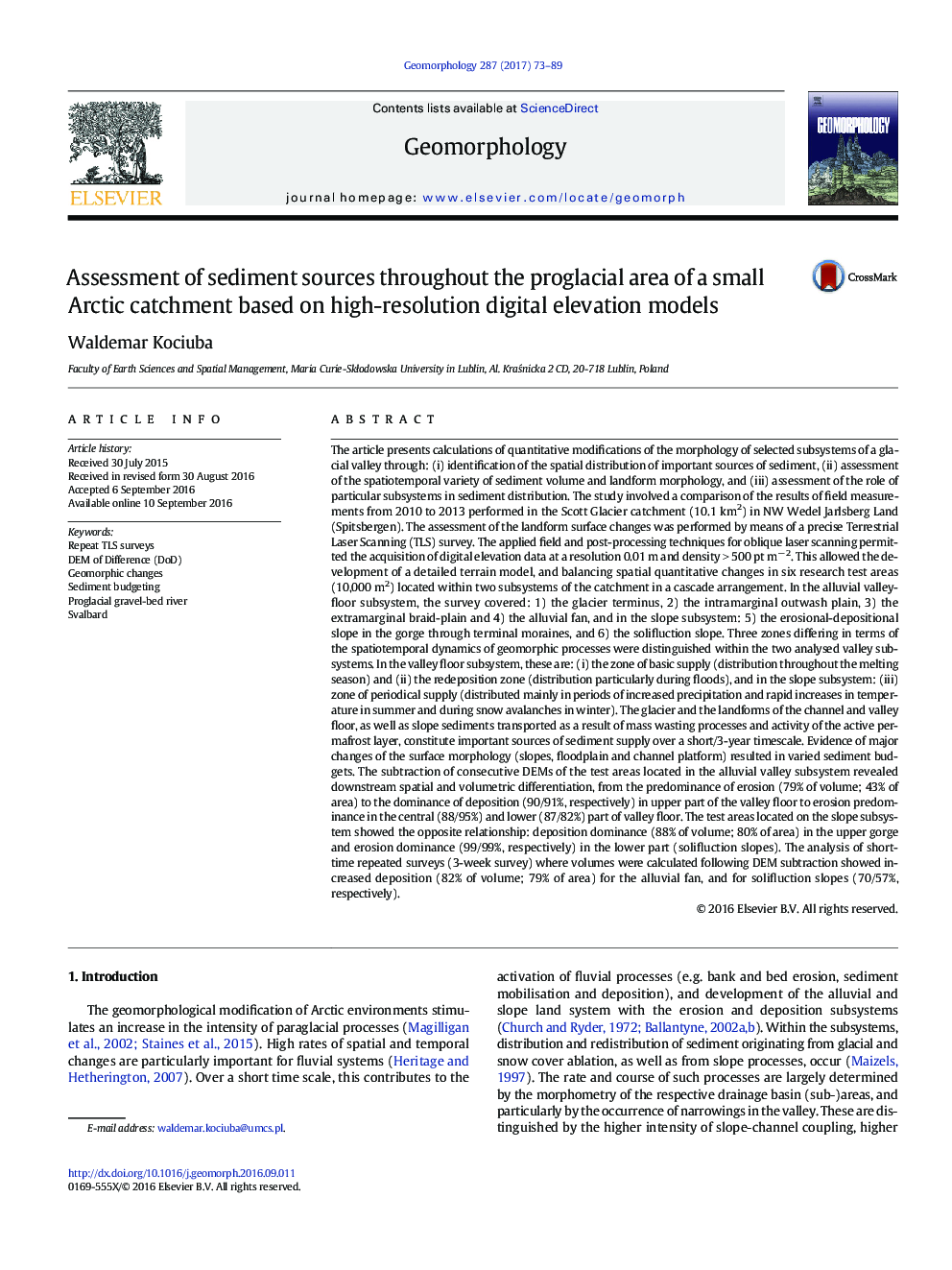| کد مقاله | کد نشریه | سال انتشار | مقاله انگلیسی | نسخه تمام متن |
|---|---|---|---|---|
| 5780987 | 1635362 | 2017 | 17 صفحه PDF | دانلود رایگان |
- TLS-based high resolution DEMs were used for analyses of surface changes.
- Quantitative evaluation of erosion/deposition rates was verified in six square plots on the alluvial and slope subsystems.
- Sediment budgeting in periods of three years and three weeks was compared.
- Sources of sediment supply in the cascade catchment system and the type of activity were determined.
- Spatial and temporal geomorphic changes in the proglacial valley were discussed.
The article presents calculations of quantitative modifications of the morphology of selected subsystems of a glacial valley through: (i) identification of the spatial distribution of important sources of sediment, (ii) assessment of the spatiotemporal variety of sediment volume and landform morphology, and (iii) assessment of the role of particular subsystems in sediment distribution. The study involved a comparison of the results of field measurements from 2010 to 2013 performed in the Scott Glacier catchment (10.1 km2) in NW Wedel Jarlsberg Land (Spitsbergen). The assessment of the landform surface changes was performed by means of a precise Terrestrial Laser Scanning (TLS) survey. The applied field and post-processing techniques for oblique laser scanning permitted the acquisition of digital elevation data at a resolution 0.01 m and density > 500 pt mâ 2. This allowed the development of a detailed terrain model, and balancing spatial quantitative changes in six research test areas (10,000 m2) located within two subsystems of the catchment in a cascade arrangement. In the alluvial valley-floor subsystem, the survey covered: 1) the glacier terminus, 2) the intramarginal outwash plain, 3) the extramarginal braid-plain and 4) the alluvial fan, and in the slope subsystem: 5) the erosional-depositional slope in the gorge through terminal moraines, and 6) the solifluction slope. Three zones differing in terms of the spatiotemporal dynamics of geomorphic processes were distinguished within the two analysed valley subsystems. In the valley floor subsystem, these are: (i) the zone of basic supply (distribution throughout the melting season) and (ii) the redeposition zone (distribution particularly during floods), and in the slope subsystem: (iii) zone of periodical supply (distributed mainly in periods of increased precipitation and rapid increases in temperature in summer and during snow avalanches in winter). The glacier and the landforms of the channel and valley floor, as well as slope sediments transported as a result of mass wasting processes and activity of the active permafrost layer, constitute important sources of sediment supply over a short/3-year timescale. Evidence of major changes of the surface morphology (slopes, floodplain and channel platform) resulted in varied sediment budgets. The subtraction of consecutive DEMs of the test areas located in the alluvial valley subsystem revealed downstream spatial and volumetric differentiation, from the predominance of erosion (79% of volume; 43% of area) to the dominance of deposition (90/91%, respectively) in upper part of the valley floor to erosion predominance in the central (88/95%) and lower (87/82%) part of valley floor. The test areas located on the slope subsystem showed the opposite relationship: deposition dominance (88% of volume; 80% of area) in the upper gorge and erosion dominance (99/99%, respectively) in the lower part (solifluction slopes). The analysis of short-time repeated surveys (3-week survey) where volumes were calculated following DEM subtraction showed increased deposition (82% of volume; 79% of area) for the alluvial fan, and for solifluction slopes (70/57%, respectively).
Journal: Geomorphology - Volume 287, 15 June 2017, Pages 73-89
